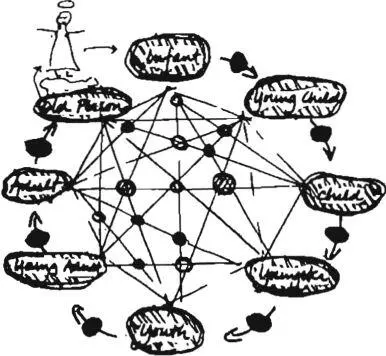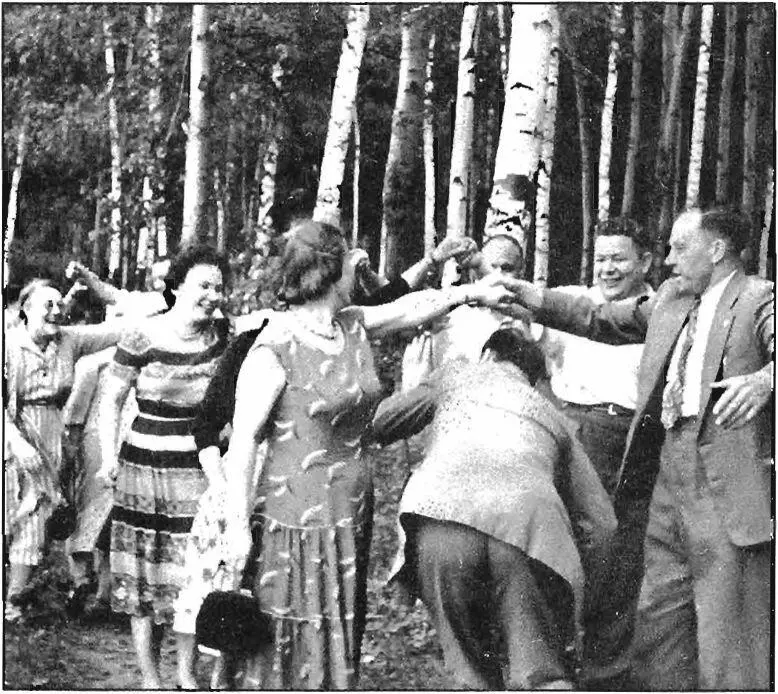Christopher alexander - A pattern language
Здесь есть возможность читать онлайн «Christopher alexander - A pattern language» весь текст электронной книги совершенно бесплатно (целиком полную версию без сокращений). В некоторых случаях можно слушать аудио, скачать через торрент в формате fb2 и присутствует краткое содержание. Жанр: Прочая научная литература, на английском языке. Описание произведения, (предисловие) а так же отзывы посетителей доступны на портале библиотеки ЛибКат.
- Название:A pattern language
- Автор:
- Жанр:
- Год:неизвестен
- ISBN:нет данных
- Рейтинг книги:3 / 5. Голосов: 1
-
Избранное:Добавить в избранное
- Отзывы:
-
Ваша оценка:
- 60
- 1
- 2
- 3
- 4
- 5
A pattern language: краткое содержание, описание и аннотация
Предлагаем к чтению аннотацию, описание, краткое содержание или предисловие (зависит от того, что написал сам автор книги «A pattern language»). Если вы не нашли необходимую информацию о книге — напишите в комментариях, мы постараемся отыскать её.
A pattern language — читать онлайн бесплатно полную книгу (весь текст) целиком
Ниже представлен текст книги, разбитый по страницам. Система сохранения места последней прочитанной страницы, позволяет с удобством читать онлайн бесплатно книгу «A pattern language», без необходимости каждый раз заново искать на чём Вы остановились. Поставьте закладку, и сможете в любой момент перейти на страницу, на которой закончили чтение.
Интервал:
Закладка:
Similar patterns of mutual regulation occur between the very old and the very young; between adolescents and young adults, children and infants, teenagers and younger teenagers, young men and old women, young women and old men, and so on. And these patterns must be made viable by prevailing social institutions and those parts of the environment which help to maintain them —the schools, nurseries, homes, cafes, bedrooms, sports fields, workshops, studios, gardens, graveyards. . . .
We believe, however, that the balance of settings which allow normal growth through the life cycle has been breaking down. Contact with the entire cycle of life is less and less available to each person, at each moment in time. In place of natural communities with a balanced life cycle we have retirement villages, bedrooms suburbs, teenage culture, ghettos of unemployed, college towns, mass cemeteries, industrial parks. Under such conditions, one’s chances for solving the conflict that comes with each stage in the life cycle are slim indeed.
To re-create a community of balanced life cycles requires, first of all, that the idea take its place as a principal guide in the development of communities. Each building -project , whether the addition to a house , a new road , a clinic , can be viewed as either helping or hindering the right balance for local communities. We suspect that the community repair maps, discussed in The Oregon Experiment , Chapter V (Volume 3 in this series), can play an especially useful role in helping to encourage the growth of a balanced life cycle.
But this pattern can be no more than an indication of work
that needs to be done. Each community must find ways of taking stock of its own relative “balance’ 3in this respect, and then define a growth process which will move it in the right direction. This is a tremendously interesting and vital problem; it needs a great deal of development, experiment, and theory. If Erikson is right, and if this kind of work does not come, it seems possible that the development of trust, autonomy, initiative, industry, identity, intimacy, generativity, integrity may disappear entirely.
| STAGE | IMPORTANT SETTINGS | RITES OF PASSAGE |
| I. INFANT T rust | Home, crib, nursery, garden | Birth place, setting up the home .... out of the crib, making a place |
| 2. YOUNG CHILD Autonomy | Own place, couple’s realm, children’s realm, commons, connected play | Walking, making a place, special birthday |
| 3. CHILD Initiative | Play space, own place, common land, neighborhood, animals | First ventures in town .... joining |
| 4. YOUNGSTER Industry | Children’s home, school, own place, adventure play, club, community | Puberty rites, private entrance paying your way |
| 5. YOUTH Identity | Cottage, teenage society, hostels, apprentice, town and region | Commencement, marriage, work, building |
| 6. YOUNG ADULT Intimacy | Household, couple’s realm, small work group, the family, network of learning | Birth of a child, creating social wealth . . building |
| 7. ADULT Generativity | Work community, the family town hall, a room of one’s own | Special birthday, gathering, change in work |
| 8. OLD PERSON Integrity | Settled work, cottage, the family, independent regions | Death, funeral, grave sites |
1 44
l 6 LIFE CYCLE
Therefore:
Make certain that the full cycle of life is represented and balanced in each community. Set the ideal of a balanced life cycle as a principal guide for the evolution of communities. This means:
1. That each community include a balance of people at every stage of the life cycle, from infants to the very old; and include the full slate of settings needed for all these stages of life;

2. That the community contain the full slate of settings which best mark the ritual crossing of life from one stage to the next.
settings to support any single stage of life
• settings to support ritual passing from one stage to another
o settings to mark
interaction between stages
The rites of passage are provided for, most concretely, by holy ground (66).Other specific patterns which especially support the seven ages of man and the ceremonies of transition are HOUSEHOLD MIX (35), OLD PEOPLE EVERYWHERE (40), WORK COMMUNITY (41), LOCAL TOWN HALL (44), CHILDREN IN THE CITY (57), BIRTH PLACES (65), GRAVE SITES (70), THE FAMILY (75), YOUR OWN HOME (79), MASTER AND APPRENTICES (83), TEENAGE SOCIETY (84), SHOPFRONT SCHOOLS (85), CHILDREN’S HOME (86), ROOMS TO RENT ( I 5 3 ) , TEENAGER’S COTTAGE ( I 5 4) , OLD AGE COTTAGE ( I 5 5) , SETTLED WORK ( I S 6) , MARRIAGE BED
(187).
SUMMARY OF THE LANGUAGE
which you can make a language for your own project, by choosing the patterns which are most useful to you, and leaving them more or less in the order that you find them printed here.
•J* *2* 4*
We begin with that 'part of the language which defines a town or community. These patterns can never be “designed” or “built” in one fell swoop—but patient piecemeal growth , designed in such a way that every individual act is always helping to create or generate these larger global patterns }will , slowly and surely , over the yearSy make a community that has these global patterns in it.
1. independent regions
within each region work toward those regional policies which will protect the land and mark the limits of the cities j
2. THE DISTRIBUTION OF TOWNS
3. CITY COUNTRY FINGERS
4. AGRICULTURAL VALLEYS
5. LACE OF COUNTRY STREETS
6. COUNTRY TOWNS
7. THE COUNTRYSIDE
| 27 MEN and women |
|---|
 |
146
. . . and just as a community or neighborhood must have a proper balance of activities for people of all the different ages—
COMMUNITY OF7OOO (12), IDENTIFIABLE NEIGHBORHOOD (I 4) ,
life cycle(26) —so it must also adjust itself and its activities to the balance of the sexes, and provide, in equal part, the things which reflect the masculine and feminine sides of life.
The world of a town in the 1970’s is split along sexual lines. Suburbs are for women, workplaces for men; kindergartens are for women, professional schools for men; supermarkets are for women, hardware stores for men.
Since no aspect of life is purely masculine or purely feminine, a world in which the separation of the sexes is extreme, distorts reality, and perpetuates and solidifies the distortions. Science is dominated by a masculine, and often mechanical mentality; foreign diplomacy is governed by war, again the product of the masculine ego. Schools for young children are swayed by the world of women, as are homes. The house has become the domain of woman to such a ridiculous extreme that home builders and developers portray an image of homes which are delicate and perfectly “nice,” like powder rooms. The idea that such a home could be a place where things are made or vegetables grown, with sawdust around the front door, is almost inconceivable.
Читать дальшеИнтервал:
Закладка:
Похожие книги на «A pattern language»
Представляем Вашему вниманию похожие книги на «A pattern language» списком для выбора. Мы отобрали схожую по названию и смыслу литературу в надежде предоставить читателям больше вариантов отыскать новые, интересные, ещё непрочитанные произведения.
Обсуждение, отзывы о книге «A pattern language» и просто собственные мнения читателей. Оставьте ваши комментарии, напишите, что Вы думаете о произведении, его смысле или главных героях. Укажите что конкретно понравилось, а что нет, и почему Вы так считаете.












